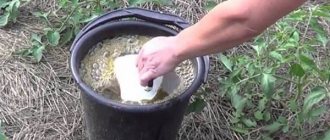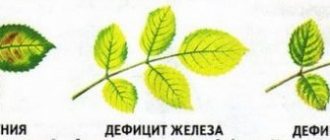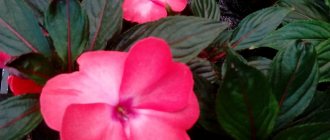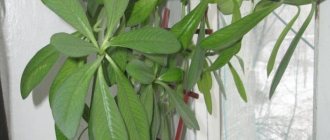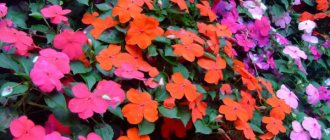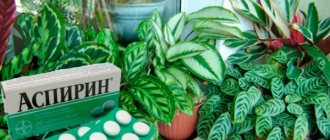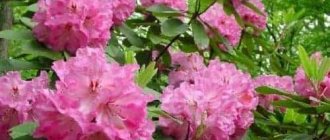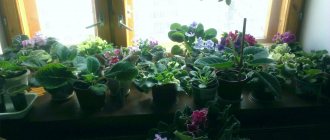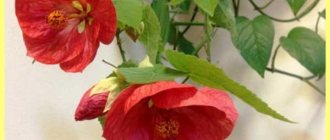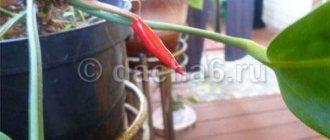Yantarin VRK - description of the product and active ingredients
Water-soluble cone is a natural growth stimulator that is used both for indoor flowers and for fruit and berry garden crops. Its use is guaranteed to activate the vital activity of all plants, accelerate the process of flowering and fruit ripening, and also increase productivity.
In addition to accelerating growth, Amber helps plantings become more resistant to diseases and various unfavorable conditions (for example, temperature changes, frosts, lack of water, etc.)
When using this growth regulator, soil microflora is normalized, and less nitrates accumulate in plant tissues.
The active ingredient of the drug is succinic acid in a dosage of 5 grams per liter. We talk in detail about the benefits of this substance in the article Succinic acid for indoor flowers: application and reviews.
When is the drug used?
Aqueous solutions of a growth stimulator from a domestic manufacturer are used at any stage of plant growth - from soaking seed material to processing fruit-bearing crops. It is used for spraying green mass, soaking the root system, and treating the crown of ornamental shrubs.
Expert opinion
Zarechny Maxim Valerievich
Agronomist with 12 years of experience. Our best country expert.
Ask a Question
A growth regulator is also used for plants that are in the recovery stage after diseases and damage by insect pests. The use of “Amber” is effective for resuscitation of dying indoor flowers, including orchids. The specific purposes of using a biological product depend on the tasks set by the gardener.
What plants is it suitable for?
Amber is successfully used for many types of garden and house plants:
- Strawberries
- Grape
- Apple trees
- Pears
- Currant
- Gooseberry
- Peach
- Plum
- Flower crops (annual and perennial)
- Home indoor plants
The use of Amber for indoor plants improves their gas exchange and cell metabolism, due to which the metabolic process is accelerated, the plant receives more energy and develops faster. This becomes possible thanks to the succinic acid contained in the fertilizer.
Storage of the drug. Safety precautions for use
Succinic acid is stored for three years in a dry place at a temperature not exceeding 25℃ . No special precautions are required during operation because:
- it does not cause poisoning in people and animals;
- getting on the surface of the skin or mucous membrane, it is easily washed off with a large volume of water;
- does not accumulate in the soil, as it is quickly destroyed by soil microorganisms.
The used drug is thrown away; reuse will not bring results.
Instructions for use for plants - how to propagate
The drug is diluted with water according to the instructions. Spraying should be carried out in the morning or evening hours, in calm weather. Mixing with other insecticides and pesticides is not recommended.
It is necessary to spray crops with Amber while wearing gloves, safety glasses and a respirator, avoiding contact of the drug with the skin. Make sure there are no children or pets nearby.
How to use the drug “Yantarin, VRK” for all types of plantings is indicated in the table:
Treatment of plants with Amber occurs by watering at the root and spraying. For indoor flowers, wiping the leaves with a cotton swab dipped in Amber and bathing the roots in the solution is also used (often used for orchids).
What to expect?
Succinic acid is not a miracle panacea like the “pill for everything” from jokes. But by using Amber to treat plants, it is quite possible to obtain a significant positive effect (see also Fig.):
- Biosynthesis in plants is activated.
- Consequence 1: growth and development are accelerated, flowering is enhanced, and crop ripening is accelerated.
- Consequence 2: plant resistance to stress increases.
- Secondary consequence 2: plant resistance to diseases increases, because their occurrence is most often provoked by stressful conditions.
- Consequence 3: accumulation of nitrates and pesticide treatment are less depressing to plants.
- Corollary 4: Excess nutrients and foreign substances are more quickly absorbed or neutralized by plants or removed from them.
- Secondary consequence 4: The quality and nutritional value of the crop is increased.
- Sick plants are easier to heal and recover faster from illness.
- The use of Amber by watering at the root activates the soil microflora, because She also needs succinic acid, see below.
- An additional consequence: the accumulation of foreign substances in the soil is reduced, and their residues are neutralized faster.
- A secondary additional consequence: succinic acid helps maintain soil fertility and the effectiveness of soil reclamation measures.
When to treat plants
Plantings should be sprayed and watered with Amber during the growing season.
It is necessary to spray the plantings in the morning or evening hours to minimize the loss of the drug from the leaves due to active sunlight. It is preferable to spray in the evening, since in this case the harm to bees is also minimized (during the night the drug will be absorbed as much as possible and the bees will not collect it).
House flowers should be watered with Amber solution at the root so as not to touch the leaves:
What is it used for?
The benefits of amber for plants are undeniable. It is affordable and easy to use and is suitable not only for orchids, but for almost all plants.
In flower care, the drug is used in cases where:
- rapid regeneration of leaves is necessary in case of frostbite or overheating;
- it is necessary to speed up the adaptation period after transplantation so that the plant does not die;
- the orchid experiences moisture deficiency, is exposed to sunburn or low temperatures;
- increased photosynthesis and saturation of leaves with chlorophyll is required;
- weak root system and cuttings need growth stimulation;
- the substrate needs healing;
- I would like to increase the duration of orchid flowering.
Application of Amber for orchids
Everyone knows that orchids are extremely capricious flowers that take root at home only with a few “selected” gardeners. But this product will help orchids to take root well and will increase the chance of breeding them at home by at least 2 times.
Method of using Amber for orchids:
- Stimulating watering at the roots is carried out once every 3-4 weeks, and only during the active growing season of plants. Keep in mind that watering sleeping orchids with Amber or any other stimulant simply means killing them! Dosage – 20 ml of concentrate per 1 liter of water. Water directly under the root, in small portions, at intervals of 1-3 hours.
- Soaking orchid roots before planting or replanting the bulb. We advise you to carry out this action together with wiping the leaves. The solution is prepared in the same way as for watering at the root. The roots of healthy orchids are soaked in the solution for half an hour; if the orchid is replanted because it is withering, the roots should be soaked for 2-2.5 hours.
Note! Orchids revived by Yantarine or other growth stimulants are prohibited from being planted in a solid container or artificial substrate until their constant flowering is restored.
Danger level
The drug Yantarin is classified as hazard class 3 for humans and hazard class 3B for bees. However, this is precisely what shows (by contrast) how arbitrary the hazard classifiers are and how important it is when working with a drug to pay attention to the specific properties of its active ingredients (AI).
Yantarine was included in the 3rd class for people, essentially, because the deliberate misuse of the drug or extremely careless handling of it can cause severe poisoning. Which is not excluded, because Amber is intended for use by unqualified users in private household plots. However, the toxicological parameters of succinic acid are comparable to those of... ordinary table salt: LD50 for rats orally 2.26 g/kg (!); for mice intravenously 1.4 g/kg. In human terms, this means that for severe poisoning with succinic acid, you need to eat it with spoons, but in reality this substance is not much more dangerous than food-grade citric acid.
Amber hazard class 3B for bees is assigned because the optimal time for its use on fruits and berries is the height of flowering (see below). But index B means that plants treated with the drug pose a serious danger to pollinators immediately after treatment, but just a day after it they become safe - in light and air in the presence of moisture vapor, succinic acid, which has not penetrated into the plants, literally disintegrates into carbon dioxide and water in a few hours.
Amber and bees
However, before spraying open ground plants with Yantarine, you need to notify nearby beekeepers (whose apiaries are in the protected zone, see below) 3-5 days in advance about the upcoming treatment. The fact is that the height of flowering of fruits and berries in beekeeping is the time when the day feeds the year. The restriction on the summer of bees for Yantarin is short-lived (also see below), but during a rush of honey harvest it can be critical for the profitability of the apiary farm. You need to respect beekeepers, if only because without pollination by domestic bees there will be no good harvest - the total activity of wild pollinators is no higher than 15-20% of that of the honey bee. That is why it is necessary to warn the beekeeper(s) to decide whether it is worth locking up the bees or whether it is better to migrate the entire apiary to a new place. It takes several days to find and move there.
Where to buy and price of the stimulator
Since this is a very popular and widespread remedy, you can buy “Yantarin, VRK” in any garden store (where seeds, seedlings, etc. are sold), in large supermarkets (Leroy Merlin, Auchan, Perekrestok, Magnit Family, etc.). etc.), as well as in online stores (but make sure that the online store has a free pick-up point in your city, otherwise you will pay more for delivery than for the drug itself).
The product is available in several volumes:
- 100 ml. – from 60 rubles.
- 500 ml – from 250 rubles
Solution or tablets?
Industrially, succinic acid is obtained from malathionic anhydride, which, in turn, is a by-product of the processing of brown coal. Amber for plants is a pure monopreparation of succinic acid. Tablets of medicinal succinic acid can be bought at a pharmacy, but one tablet will contain 0.1 g of DV, and the rest is a filler (talc, chalk) and, possibly, additional substances that are useless to plants. For spraying and introduction into drip irrigation systems, a solution of “tablet” succinic acid is of little use, because contains a micro-suspension that clogs the nozzles, nozzles and capillaries of the dispensers. For the same reason, orchid leaves need to be washed with water a certain time after treatment with medicinal succinic acid (see below), which once again disturbs the oppressed plants.
Amateur plant growers often use pharmaceutical succinic acid to treat plants, but due to the presence of ballast and additional substances in the tablets, they have to be dissolved for use on plants with the preparation of a mother solution, and the effect of the treatment is less than the maximum possible. The agrotechnical preparation of succinic acid is a water-soluble concentrate (WRC) without ballast and additional additives, easily soluble in any technological container - sprayer tank, watering can, etc. Succinic acid dissolves well in water and the Yantarine working solution does not clog technological agricultural equipment. After manual treatment of plants with Amber, no additional care is required.
Recalculation and recalculation
It is simple to dilute Yantarine instead of pharmaceutical succinic acid: only a simple recalculation of the amount of the drug is required: 1 tablet per 0.1 g of DV = 50 ml of Yantarin VRK. Or 100 ml VRK = 2 tablets. Recalculation of the costs of the drug also shows its benefits, because Yantarin VRK is available in packaging starting from 100 ml; medical succinic acid - plates of 10 tablets. Here you also need to take into account that the liquid preparative form in the container unit of the bottle makes it possible to sample the drug in portions throughout the shelf life, which is generally not possible for succinic acid powder in bags.
Reviews from gardeners about Yantarin VRK
- Elena Dmitrievna. What I appreciate most about Yantarine is that it is a natural product and it is safe for people, animals and nature. I grow tropical plants at home - and they are notoriously capricious. In winter, it is very difficult to preserve them because of the dry air from the radiators - before, I either dried out or flooded my flowers, and it was a lot of pain. A neighbor advised me to try this remedy (and, in principle, Succinic Acid) - she was a biologist and worked in phytosanitary supervision, so I trust her. Of course, I bought the product, read the book with instructions that was stuck on the back - I’m delighted, why didn’t I know about it before? I won’t describe it, it’s all easy to find. In my case, it helped regulate excess and lack of moisture, from which my plants previously suffered so much. This preparation can be used in several ways: watering at the root gives rapid growth and formation of greenery. Treating seeds with it gives increased germination. Treatment of cuttings increases root formation. The main thing is to use it no later than 15-20 minutes after dilution, otherwise the succinic acid will evaporate.
- Valentina. I want to share my delight with this growth stimulator - a miracle remedy! I once bought myself an orchid at Ikea, on sale. Of course, it was already inferior - the leaves were yellow and hanging, there were almost no roots. I decided to nurse. Watered by immersing in a warm solution. The turgor became stronger, the roots began to grow, my orchid survived! I saved her, I’m very proud! But without Yantarina, naturally, it would not have worked. So this is a powerful remedy, tested on myself and I recommend it to everyone from the bottom of my heart!
Useful articles:
Action
Chemical formula of succinic acid
In reputable sales brochures, Amber is positioned as a plant stimulant; sometimes - as a growth stimulant, which is also true to some extent. But succinic acid (formula in the figure on the right) is not an auxin-like compound and not a phytohormone at all. Its stimulating effect is of a different nature.
The vital activity of all living organisms is ensured by special substances, the so-called. high-energy (energy-intensive) – energy storage and transporters. Macroergic compounds of living beings are known about. 40. Of these, the most important is adenosine triphosphoric acid (ATP); The role of guanosine triphosphate (GTP) is also significant.
Macroergic substances are formed in organisms in three jointly acting ways:
- In the respiratory chains;
- Poxidative phosphorylation;
- The so-called general path of catabolism.
The general path of catabolism provides, in addition to direct energy carriers, substrate substances for mitochondrial respiration. In plants as producing organisms, the role of the general catabolic pathway is especially important. The central phase of this biochemical process is the so-called. the tricarboxylic acid cycle, or the Krebs cycle (after the name of one of the discoverers), or, not entirely correctly, the citric acid cycle.
Note: Hans Krebs and Fritz-Albert Lipmann were awarded the Nobel Prize in Chemistry in 1953 for their research into the common pathway of catabolism.
Scheme of the tricarboxylic acid cycle on the general catabolic pathway
Succinic acid is one of the links in the tricarboxylic acid cycle (shown in the blue frame in the figure on the right), but the link is critical. Due to its relatively small molecular weight and simple chemical structure, the hydroxyl groups of succinic acid are chemically very active. But for the same reasons, succinic acid easily decomposes in light and air or is lost by plants through simple diffusion. To replenish its “unplanned” loss, the plant organism has to spend a good share of the energy received from light and nutrients.
Feeding plants with succinic acid releases this energy to activate life processes. Let us imagine, figuratively speaking, a goner smoked to the ends of his hair. And so, a certain pill appeared in pharmacies, the use of which clears his lungs until they are pink, like those of a strong baby. The effect of succinic acid on plants is somewhat similar to the effect of such a hypothetical medicine.
What about mushrooms?
In some manuals and product descriptions, succinic acid is credited with the properties of a fungicide or even a universal pesticide. This is not true. Plant cells are covered with an outer cellulose membrane on top of the cell membrane - succinic acid diffuses through it. Animal cells do not have a special protective shell - they are protected by the outer integument of the body, which provides the animals with mobility. But fungal cells are covered on top of the membranes with a continuous layer of chitin. Even the thinnest chitinous layer is impermeable to succinic acid, so it does not act on fungi by contact and is not absorbed by their hyphae. The correlation of the use of succinic acid on plants with the degree of their susceptibility to phytopathogens and pests is false, because the increased resistance of plants in this case is simply due to the stimulation of their vital activity by the drug.
How does it work on orchids?
Succinic acid is an environmentally friendly drug, as it is produced from natural raw materials, which is another advantage. The influence of amber on an orchid significantly improves its condition and stimulates its development. An orchid is a very capricious plant and can hardly tolerate replanting, especially at the time of flowering. Succinic acid helps it quickly cope with new growing conditions and adapt to the microclimate.
The use of the so-called medicine in caring for orchids contributes to the growth of green mass. New roots begin to form, the leaves of the plant become strong and elastic, and more and more beautiful buds appear.
For your information! It is necessary to take into account that the use of succinic acid is cumulative. It takes time to see the positive effects of its use. But you shouldn’t get carried away with it. It has the property of acidifying the soil.
How to use succinic acid for indoor flowers
The product can be successfully used for indoor flowers. This will allow them to come to life literally within a week.
Make an aqueous solution of succinic acid at the rate of 1 g of powder in 5 liters of warm water, stir and pour the flowers under the root. You will already notice the results within a week and you will be more than surprised. In indoor flowers. The leaves will turn green and new buds will appear on flowering plants.
However, do not forget that this is not a supplement, but just a stimulant and therefore should not be used frequently. Once every six months is enough.
